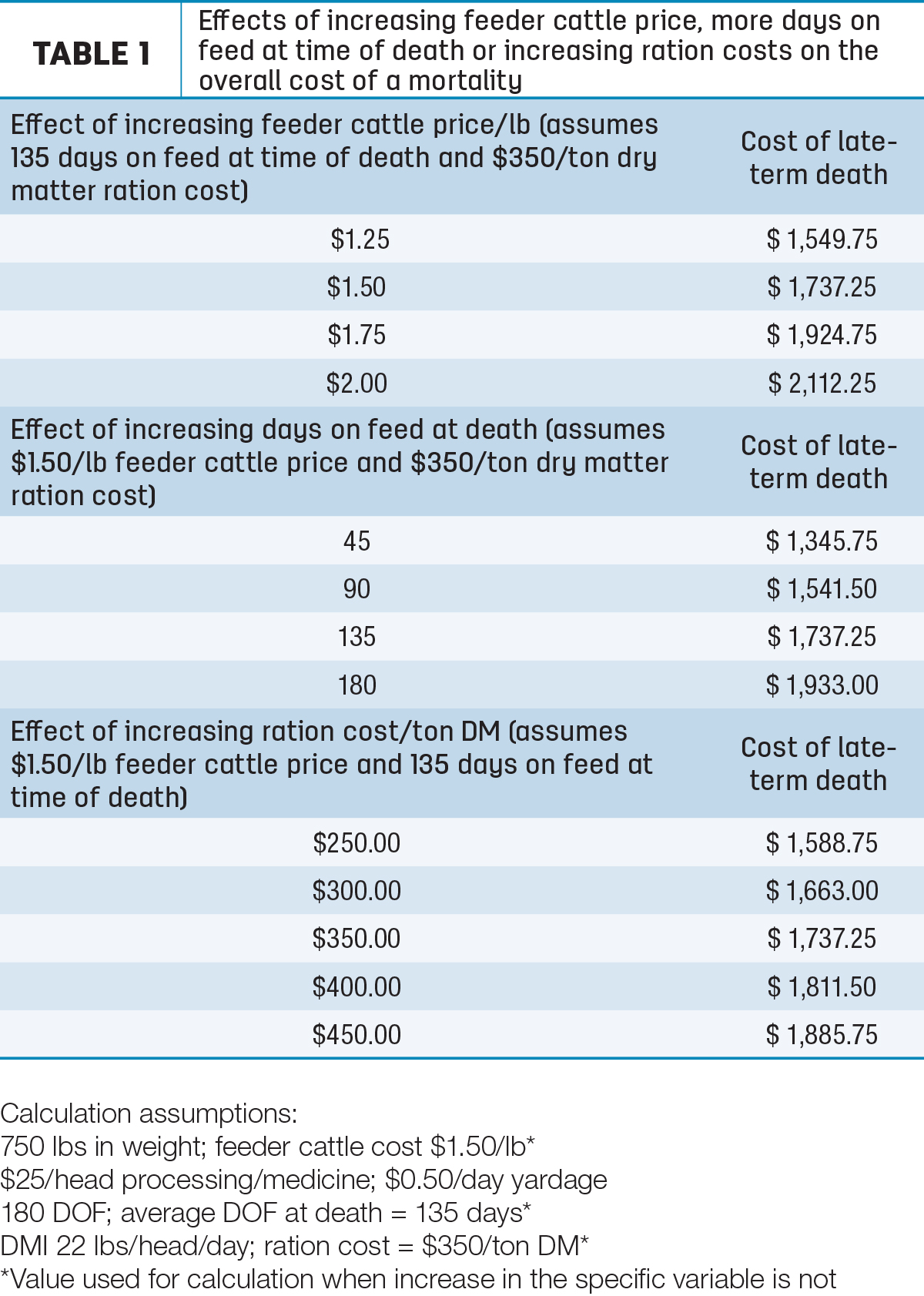There has been a lot of discussion about late-term death loss in finishing cattle in recent years. There are obvious economic consequences of losing an animal that has been on feed for a long period of time, and those costs increase as feeder prices and feed costs increase.
There is also the often-unaccounted-for opportunity cost of not marketing the animal when the pen is sold. Additionally, those involved in managing the cattle are negatively impacted when the animals they care for die. These factors all contribute to diminished economic returns and reduced morale for the feedyard team if late-term death loss is greater than expected.
For the purposes of this article, I define late-term death loss as cattle that die in the last half of the feeding period. The average days on feed for a finishing animal is approximately 180 days, which means we are talking about cattle that die in the last 90 days of the feeding period. Average rates of death in this period can range from 0.07% to 0.11% for every 10 additional days the cattle are fed, but some groups of cattle can have a much greater death loss rate than that. Additionally, the rate of late-term feedyard death loss is slightly greater in heifers than in steers.
Economic impact
The economic cost of an animal dying is not uniform, and various factors impact that cost. In Table 1, you can see the impacts of feeder cattle price, days on feed at time of death and ration cost on the cost of an animal dying late in the feeding period.

In this scenario, the baseline days on feed for a late-term death is 135 days, which represents an animal dying after being fed for 75% of the feeding period.
- For every 25-cent increase in feeder cattle price, there is a $187.50 increase in the cost of an animal dying because the purchase price of that animal has increased.
- For every 45 additional days on feed at time of death, there is a $195.75 increase in the cost of an animal dying because of the additional yardage cost and feed consumption.
- Finally, for every $50 increase in ration costs per ton of dry matter, there is a $74.25 increase in the cost of an animal dying because of increased feed costs.
As the feeding period progresses, the cause of death for cattle shifts from predominantly bovine respiratory disease (BRD) to digestive upsets and feedyard-associated acute or atypical interstitial pneumonia (AIP). This phenomenon was observed by researchers when they reported that the average days on feed at time of death in finishing steers was 62, 99 and 105 days for BRD, digestive upset and AIP, respectively. The reasons for greater digestive upsets later in the feeding period are clear. The longer the period that cattle are fed high-starch diets, the more likely they are to encounter an event such as inclement weather, illness or an improper feed call that can lead to inconsistent feed intakes and, ultimately, acidosis and bloat. In the case of AIP, the etiology is less clear, but factors that are correlated to an increased incidence include high ambient temperature, airborne dust and infections.
Mitigation strategies
Due to the nature of most late-term feedyard deaths, common tools for managing health challenges such as vaccines and antibiotics are of limited utility. Management practices such as dust control and proper bunk management will help minimize the impact of other factors, but the options for mitigation are limited. Recent commercial research trials have shown that one tool for managing late-term feedyard death loss is the application of a bacteria called Megasphaera elsdenii. In a seven-trial pooled analysis of those studies representing 17,571 head, cattle given M. elsdenii at terminal processing (terminal implant and/or terminal sort) experienced 36% fewer deaths later in the feeding period when compared to cattle in the control group. M. elsdenii is a bacterium that metabolizes lactate and converts most of it to a less potent organic acid called butyrate. Butyrate is extensively metabolized by the rumen wall and its metabolism stimulates growth of structures on the rumen wall called papillae, thereby increasing the absorptive surface area of the rumen. Both features of M. elsdenii improve the ability of an animal to handle an acid load in the rumen, which can be very important in compromised cattle.
Minimizing late-term feedyard death loss is important to finishing cattle operations, both from an economic and morale standpoint. However, given the etiology of those deaths, producers must focus on management throughout the feeding period and consider alternative technologies that are outside of the traditional disease prevention and treatment tools.
References omitted but are available upon request. Click here to email an editor.








